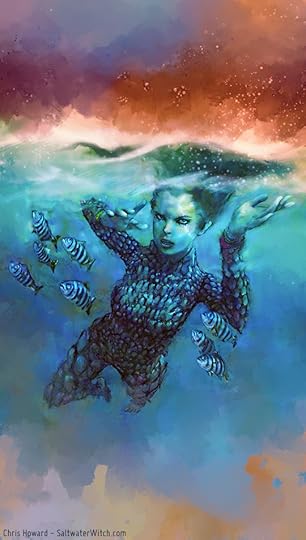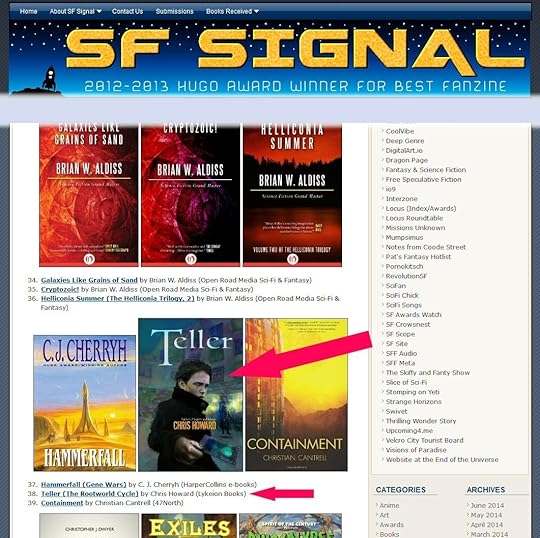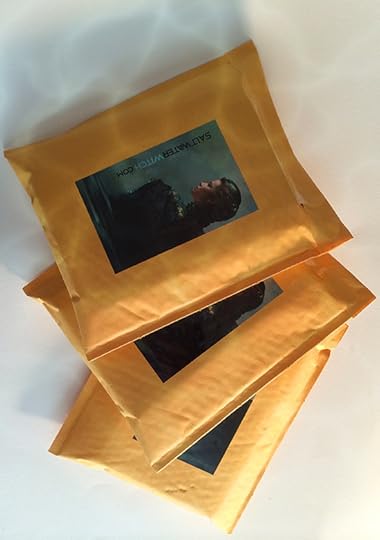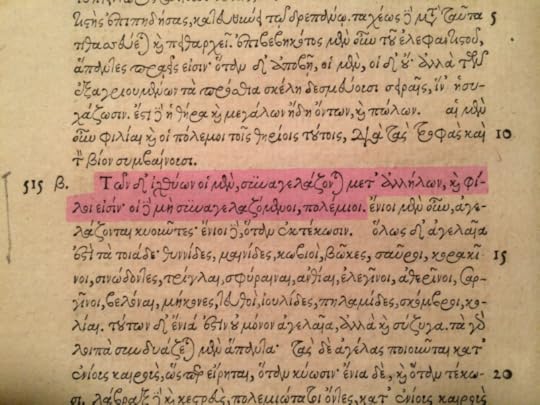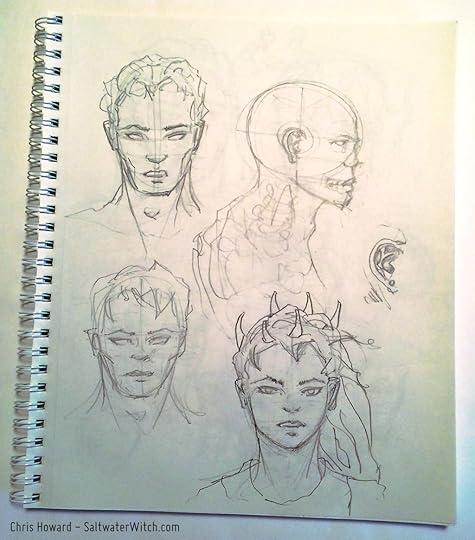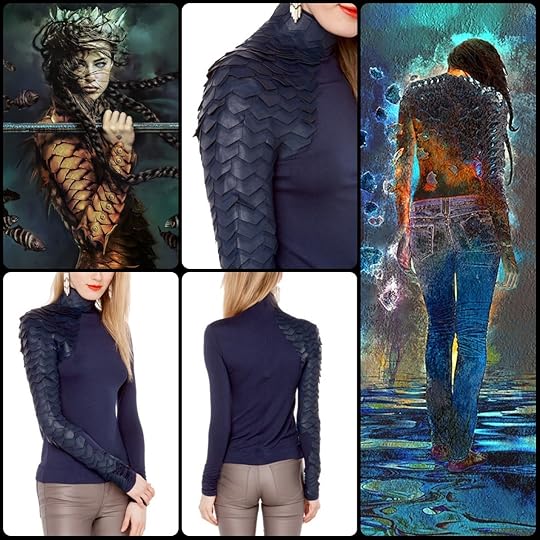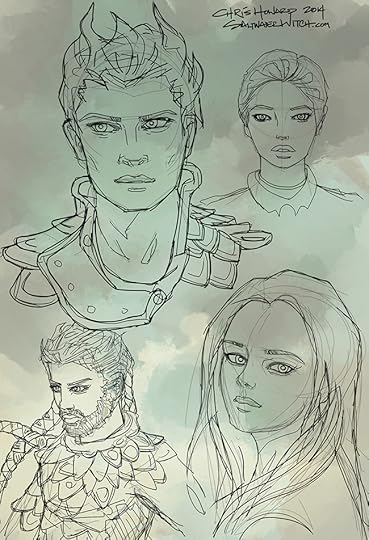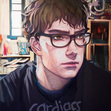Chris Howard's Blog, page 78
June 5, 2014
Teller is 38th!
SF Signal just posted 314 Science Fiction, Fantasy and Horror Kindle eBook Deals $3.99 or Less, and Teller is 38 on the list!
May 12, 2014
Goodreads Giveaway for SaltwaterWitch Done!
Forgot to post this over the weekend, a shot of the books–with some art and stickers–going out to the three winners. Congratulations!
May 10, 2014
Seeds of a story
I don’t know if you know this about me, but I studied philosophy in school–focusing on Aristotelian philosophy. I used to collect Aristotle’s works–and everything related to Aristotle. That’s biographies, commentaries, translations, just about anything on, about, or by Aristotle. My Aristotle library is somewhere between 200 and 300 books, in half a dozen languages–mostly English, Greek, Latin, but a handful in Arabic, German, some of them old, six or seven from the 1500s, including the beautifully typeset Sylburg edition of Aristotle’s Historia Animalium.
One line in HA started me down the path that eventually led to the story that became my novel, Salvage (Masque/Prime Books). But before we get to the English translation of the line, I want you to see the beauty in the type in this and all of the Greek editions Friedrich Sylburg did for the publisher, Johann Wechel. The highlighting in the image is the specific passage that got me started on Salvage, but on to that in a bit. Just look at the type on this page printed in Frankfurt in the late 1500s. It doesn’t matter if you can read this or not, you can see the artistry, the elegance, the power of language–and of course, this goes for just about any language.
You can see that the last word in the highlighted section is “polemioi”, from which the English word polemic is derived. My favorite English translation of this passage is:
“Among the fishes some form shoals with each other and are friends, while those that do not shoal are at war.”
Everything that happens in Salvage started with me thinking about this line and wondering what happens when the shoaling fish–the “friends”–become the predators?
 Amazon.com
Amazon.com Amazon UK
Amazon UK Barnes & Noble
Barnes & Noble Kobo
Kobo Apple iBooks
Apple iBooks Weightless Books.
Weightless Books.
March 30, 2014
A give-away question for you…
Would you be interested in winning pages from my sketchbooks? Here’s an example pic of a typical page: couple quick and creepy vampire dudes, apparently I was contemplating the weirdness of the human ear, and a front-facing Kassandra with her crown. Some of the sketching is years old, but there’s usually a mix on the pages. I may also cut up a few as well, and give away just a sketch of Kassandra, Kallixene, or some of the Rexenor soldiers from Saltwater Witch.
This is part of a plan to do a couple book giveaways for the print edition of Salvage—outside of Goodreads. I usually include a few art prints and stickers for GR winners, but now I’m thinking of including some hand-drawn stuff.
Good idea? Let me know! I’ll take likes/pluses as a good sign!
Check out Salvage here: http://www.amazon.com/dp/B00ED0081O
March 29, 2014
Nanowhere – Comic Edition
Did I tell you there’s a comic edition of Nanowhere in the works? (Right now it looks like a December 2014 release for Vol. 1). Here’s a concept sketch for the opening page, with Kaffia breaking the top panel to flip off the annoyingly loud gunships going overhead. They’re on their way to capture Straff, who’s hiding in the woods that surround the skatepark. In the book (Get it at Amazon, B&N, iBooks, etc.) Kaffia and Alex come in on the second scene of the first chapter, but I want a mood-setting intro into the story. This may be it, or It may not be it.
Nanowhere… it’s a love story with all the usual elements: rogue soldiers, computer hacking, tyranny, cryptography, hit-men with an affinity for rolled adhesives, rebellious skateboarders, and sentient billion-node self-organizing nanotech ghosts. Oh, and Kassandra from Saltwater Witch makes a couple appearances.
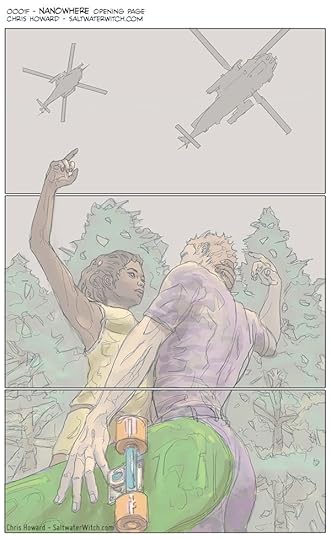
Kaffia and Alex, Opening Page of Nanowhere Comic
March 18, 2014
Scale armor shirt…
This is just so cool. Kassandra would buy this in a second. http://www.shopakira.com/products/gra...
March 16, 2014
Sketching for Saltwater Witch 16
Spent some time sketching in Art Rage on the iPad, character studies for the House Rexenor soldiers that are going to start gathering now that Kassanda’s on the scene. These are for Saltwater Witch chapter 16 and 17. http://www.SaltwaterWitch.com
.
February 2, 2014
Mermaids with crowns
Not just Starbucks… Kassandra from Saltwater Witch, Seaborn, Sea Throne…with her buddy, Ephoros–he’s the guy with the sharp teeth. Spent a long time on this one, working in a lot of detail, about eight hours in CS6 and AR4. I’m probably going to use this for the intro page to the Saltwater Witch Comic 16. This is also a good one for those of you who want to know what the Wreath really looks like (her crown).
http://www.SaltwaterWitch.com/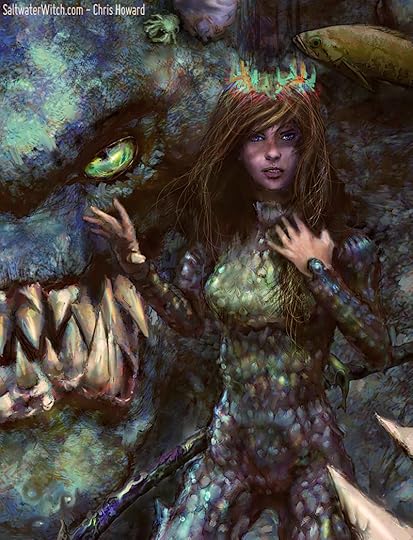
January 7, 2014
Fantastically Evil
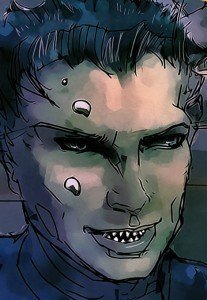 What if the villain in the story values the same things as the hero? Here’s my post for the September Fantasy Roundtable—Evil and the Fantastic.
What if the villain in the story values the same things as the hero? Here’s my post for the September Fantasy Roundtable—Evil and the Fantastic.
I started out with the idea of spinning this topic away from the Saurons of the genre—the supremely bad players with vast armies of hideous soldiers and architecturally magnificent but poorly-lit fortresses, players who want to take over extensive amounts of someone else’s territory, an entire world, or some valuable plane of existence. I wanted to spin this topic toward the blended moralities in Glenn Cook, Joe Abercrombie, Brent Weeks, and others, where the main characters are not always good, and some are clearly great fans of seeing others in pain—proudly wearing their “Go Sauron” jackets when off screen.
On the other hand I know the “evil protagonist” thing is all the rage. Every fantasy and SF discussion group on Goodreads and the Amazon forums has a dozen threads on “books where there main character is evil”, or something like that.
What about the good villain—or apparently good villain? I don’t mean where the villain thinks he’s doing the right thing, because that’s pretty much what drives every complexly-written scoundrel. Power-hungry, ladder-climbing, step over the bodies of your superiors to get what you want types of characters are the mainstay. Power, money, control—these are the things that motivate so many baddies, along with a generous portion of justification for whatever they are after.
Another common theme is the bad guy or girl who must do something evil in order to survive —kill, drink blood, go all Mr. Hyde on us, or do bad things as the result of some curse. Come on, doesn’t everyone deserve to survive? Every reader can understand that kind of drive, and in many cases it’s the thoughtful appreciation (and sometimes sympathy) that shapes the reader’s reaction to the villain’s actions, usually based on the physical and emotional price paid by the afflicted character in order to fight or throw off the curse.
Still, that’s still not quite the evil I’m thinking about—or the “good” when I say “good villain.” Like many writers I spend a lot of time thinking about evil—evil people, as well as their actions and motives. First, someone tell the NSA I was just doing research. Second, here’s where I’m going:
What if the character or characters who represent evil in a story want to help develop the world instead of destroy it? What if they benefit as much as the heroes, the shopkeepers, as much as the simple but courageous village gardeners from the worldwide advancement of magic, technology, living conditions, clean water, and green pastures? What if they are as turned off by a giant volcano spewing reeking sulfurous clouds as any hero? What if they are against war of any kind?
I started down this path in Teller, with the principal evil character making it clear that she wants all of humanity to progress. She’s even willing to help in an underground, organized-movement sort of way—you know, duffle-bags full of cash, “removing obstacles”, and other varieties of influence in the right places. Teller is contemporary fantasy, and so the characters are living in a world with runes, rockets, and Reddit. Think of hundreds of “evil” characters around the world, nominally working together, with the common goal of getting rid of humans. Not by wiping them out—that would be messy, but by making sure that civilization either advances to the point where humans can travel to other planets—getting the majority of them offworld, or to the point where humans develop the technology to “digitize human consciousness” and go virtual—with two paths from there: withdrawal into some localized computational substrate with a small realworld footprint (e.g., “still here, but quiet and out of the way”), or by extending the range of exploration by sending “digitized human freight” to planets lightyears away and decanting the data into physical forms on the other side (e.g., “grass is always greener colonization strategy”). The baddies want our world after all—and although they really don’t get along, there is one clear and shared requirement for the take-over: they want the world in move-in condition. Furnished would also be a nice perk.
I continued plotting and writing using this flavor of evil with my latest book, Salvage, where the principal evil character, Damaris, is completely open to discussions with one of the protagonists, and even hints that he’s going to invest in the character’s company, Knowledgenix, which develops advanced autonomous robots. Damaris genuinely likes Jon Andreden, and wants to help him succeed.
Evil in the fantasy genre doesn’t have to mean miles of wasteland, ever-present storm clouds, minions with sharp weapons and low morale, or any mode of transportation that involves chiropteran wings—although I am a fan of some of these, especially the wings. To me, a villain who shares values with the protagonist frightens me more than any straightforward grab for land, money or power. It totally freaks out the heroes, too.
BIO:
Chris Howard is just a creative guy with a pen and a paint brush, author of Seaborn (Juno Books, 2008), Salvage (Masque/Prime Books, 2013), Nanowhere (Lykeion, 2005), and a shelf-full of other books. His short stories have appeared in a bunch of zines, latest is “Lost Dogs and Fireplace Archeology” in Fantasy Magazine. His story “Hammers and Snails” was a Robert A. Heinlein Centennial Short Fiction Contest winner. He writes and illustrates the comic Saltwater Witch. His art has appeared in Shimmer, BuzzyMag, various RPGs, and on the pages of books, blogs, and other interesting places. Find out everything here: http://www.SaltwaterWitch.com
January 3, 2014
Saltwater Witch Comic 16 Cover
I’m working on the cover for the next volume of Saltwater Witch Comic–16. I wanted Kassandra trapped underwater between forces she can’t control. About six hours in AR4 and CS6. Saltwater Witch: www.saltwaterwitch.com